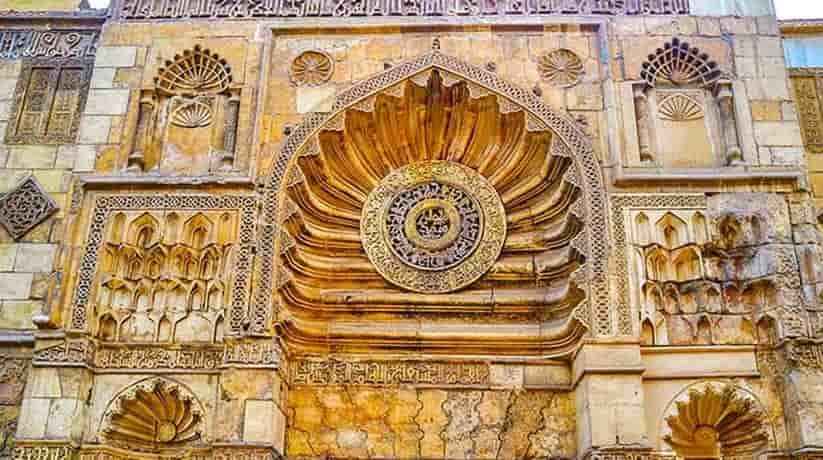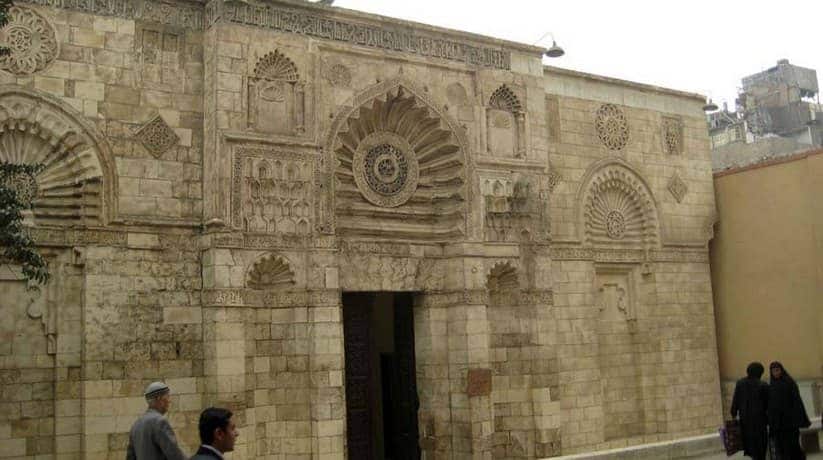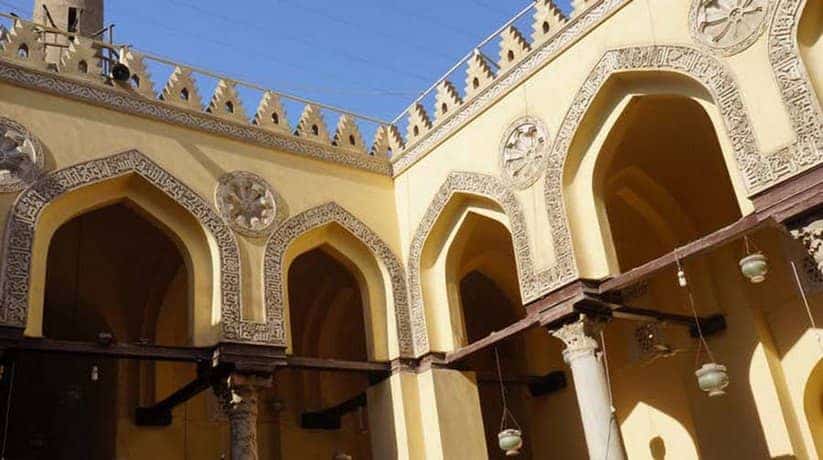Al Aqmar mosque Cairo, Egypt information, tours, booking
Al Aqmar mosque Cairo located in the heart of Cairo city. In fact, Al Aqmar mosque located north of the site which once occupied by the great Fatimid. Moreover, Al Aqmar means the Moonlit and sometimes also known as the Gray Mosque. The mosque Cairo founded by Ma’mun al-Bata’ihi, during the caliphate of al-Mustanser. Moreover, it built during a time of great political and spiritual crises for the Fatimid regime. It located on the main artery of the city. In plan, it is a regular, rectangular hypo-style mosque with a square courtyard. It is the plan of a small congregational mosque. This structure is of major importance for Cairo’s architecture for several reasons. Al Aqmar mosque Cairo indeed is one of the seminal monuments in Cairo’s architectural history.
Al Aqmar mosque is the first mosque with an entrance which is not on an axis with the qibla wall. Here, the facade follows the alignment of the street, while the qibla wall oriented to Mecca. The mosque is the first with a ground plan adjusted to an existing urban street plan. A phenomenon which over the ensuing centuries was to become common and complex. Here, the plan is rather simple. The interior of the mosque has a regular layout with the exception. The exception is that the facade wall is thicker on one end than the other. Into the thicker part of the wall, a vestibule, a staircase and two rooms opening into the interior. Al Aqmar mosque Cairo is also the first mosque in Cairo to have a decorated stone facade.
Further details about Al Aqmar mosque Cairo:
The facade is brick which faced with stone. A wing to the right of the entrance salient covered up by a later house. In the 1980s, a restoration unveiled the hidden part. It returned the facade to its original balanced proportions. This restoration done by the Bohara Indian sect. The middle of the tripartite composition dominated by a protruding portal. It decorated with a large keel arch niche. They carved with fluting radiating from a central medallion. It is like a sunrise or shell motif. The medallion has the name of Muhammad repeated in a circular interlacing pattern. It forms a circle, with the name ‘Ali at the center, all in Kufic and pierced right through the stone.
This is all surrounded by a circle of arabesque. And also of pierced Kufic, with a final circular band decorated with interlacing scrolls. The work of engraving and piercing shows both skill and perfection. The ribbed shell hood of the entrance salient is with its pierced medallion. It appears here for the first time. Moreover, it was the prototype of all the later ribbed. Moreover, it is blind and keel arch decoration which remains somewhat vogue on Cairo’s buildings. The niches on either side of the entrance each crowned with four tiers of stalactites. Set back within these are two smaller ones. Each has a small fluted semi-dome. Above these two niches are two small ones. Each has a fluted hood and supported by two engaged columns.
More details about Al Aqmar mosque Cairo:
To the left of the portal another shallow niche. It repeats the sunrise or shell motif with a medallion in the center. Above it, a circular clean cut in the stone reveals the brick wall. It indicates that a medallion once existed there. Two lozenges, one with geometric carving and the other with a vase and plant motif. They surmounted on both sides of the missing medallion by two strange, carved panels. The one to the right represents a closed door. It is like the door of Al Hakim. It is now in the Islamic Museum. The one to the left shows a niche with a geometric grill resembling a window. From its apex hangs a lamp. Al Aqmar mosque Cairo has a symbolic meaning within a Shi’a context.
The two plants standing in the vase has interpreted to be symbolic of Hasan and Husayn. They are the sons of the Caliph ‘Ali by his wife Fatima. This pattern is also repeated in Christian Coptic art. There are many examples existing in the Coptic Museum in Old Cairo. The niches with the hanging lamp and closed door placed. On each side of the missing medallion there is more decoration. There are three inscription bands that run along the facade of Al Aqmar mosque Cairo. The first is at the summit. It contains the name of Al Amir Bi-Ahkam-Allah. And next to it is the name of his Wazir (Minister) Ma’mun al-Bata’ihi. They are together with his titles, and the date of foundation. The second runs at the springing of the entrance arch.
Further details about mosque of Al Aqmar Cairo:
In fact, it also contains the names of al- Ma’mun and his titles and the date of foundation. The third band runs at the level of the door lintel and only contains verses from the Quran. Another special feature of the facade is a corner which carved with the names of Muhammad and ‘Ali. The original minaret of Al Aqmar mosque Cairo has not survived. We can see on the left door jamb of the portal the circular base of the minaret. It built in the late fourteenth century by Amir Yalbugha Al Salami. In fact, it is a brick construct which covered with stucco chevron. Moreover, it carves and a molding with open work bosses and a stalactite cornice. Above the balcony, the structure is of even later date. The interior of the mosque has not retained much of its original form.
The small sanctuary has three aisles and faces the courtyard with only a triple arcade. The closet door of Al Aqmar mosque Cairo features a fine example of Fatimid wood. It is with panels of arabesque ornament. On the northwest side of the sanctuary. The three other arcades have only one aisle each. Bands of Quranic verse in Kufic script on an arabesque background still survive. They are around the keel arches of the courtyard, which supported on marble columns. The keel arches did not appear in Egypt until the latter part of the Fatimids period. They first seen in the dome of Sheikh Ynis, attributed to Badar al-Gamali. The spandrels decorated with shallow saucers. They composed of eight ribs radiating from a central medallion.
More details about Al Aqmar mosque Cairo:
There is special feature of the interior architecture. It is that each bay’s ceiling covered by a shallow brick dome instead of being flat. In fact, it is except for the aisle parallel to the qibla wall, which is wider than the rest. Moreover, it covered with a flat wooden ceiling. Al Aqmar mosque Cairo was in ruins when the Mamluk Amir Yalbugha al-Salami restored it in 1396/97. (799H). Some scholars assume that he also restored the ceiling. The ceiling hase been flat. This type of ceiling not known from the Fatimids period. It used in the early fifteenth century at the mosque of Faraj Ibn Barquq. Yalbugha al-Salami also restored the minbar of the mosque. It retains its Fatimid ornament. It can observed on the entrance arch and at the back of the speaker’s seat.
Nothing of the original interior decoration remains. It is except some wood carving on the beams and doors. Moreover, it is also except a stucco inscription band along some of the arches. The mosque once again restored in the nineteenth century. It was during the reign of Muhammad Ali by Amir Sulayman Agha Al Silahdar. Al Silahdar also built the mosque across the street from this one. Al Aqmar mosque Cairo was not at street level as it is today. In fact, it was much higher than the street and stands above a row of shops. The rising ground level has now buried the these shops. At the time, they had an important function. The income of their rents were waqf.














